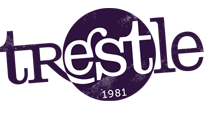Our Mask Making Process
Trestle’s Mask Department is based at Trestle Arts Base, St Albans. This creative space is where all Trestle’s masks are handmade by our full time maskmakers.
From here our small team hand craft all of the Trestle Masks, vacuum forming, cutting, sanding, and painting each one by hand. Each mask is made from a clay mould that our mask makers design and create for every new set or commission. There are three main rooms in the mask department, the vacuum former room, the spray room and the main workshop.
The moulds used in the vacuum form process are made from resin. Our Trestle masks were originally cast in the early 90s and are still the same ones we use today. Each year there are roughly 600 sets of masks made and dispatched by our team all over the world.
1) We select one of our pre-made resin mask moulds.
2) We pull the heating elements over the plastic and leave for approximately 40 seconds or until the plastic is soft and has just started to dip in the middle, this happens at around 100 degrees.
3) The mask mould is placed into the vacuum former and the tray is lowered. We place the sheet of 2mm HIPS plastic into the machine and secure it in place checking that there is an air tight fit We remove the heating element and raise the tray with the board on and turn on the vacuum pump.
4) After about 20-30 seconds we see that the plastic has taken to the contours of the mould. We lift the plastic off the mould and let it cool for a moment.
5) We cut out the mask from the remaining plastic with a saw, leaving the offcuts to be recycled back into sheets of plastic by our supplier.
6) Our moulds have indents where the eye and elastic holes should be, therefore it is quite easy for us to drill these holes, using an 8mm drill for the eye holes and a 6mm drill for the elastic holes.
7) The Masks are hand cut to shape and all holes and rough edges are filed smooth.
8) We also sand around the edge of the mask so that it is smooth and comfortable to wear.
9) Finally, we finish off the mask by hand painting the features with black spray paint.
10) This dries very quickly.
11) Once all eight masks of the basic set are made, we package them up safely in a Trestle box along with elastic, foam pads.
12) These boxes are distributed all over the world.












